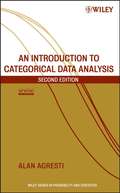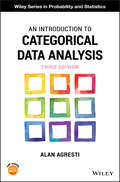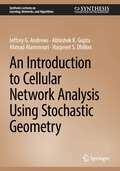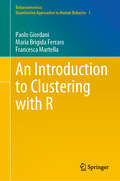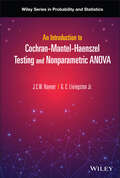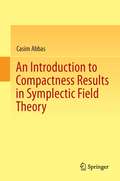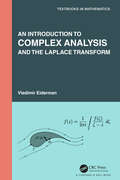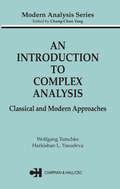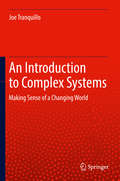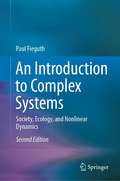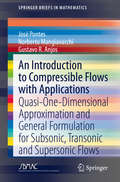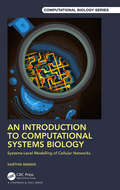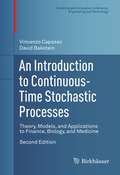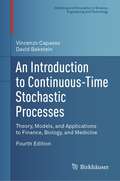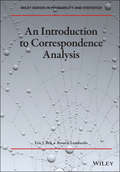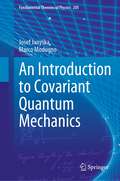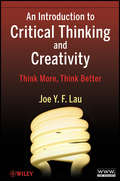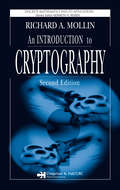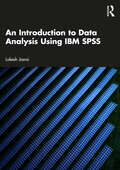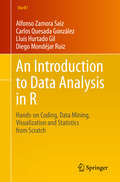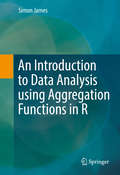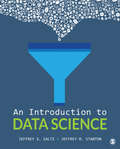- Table View
- List View
An Introduction to Categorical Data Analysis
by Alan AgrestiThe use of statistical methods for categorical data is ever increasing in today's world. An Introduction to Categorical Data Analysis, Second Edition provides an applied introduction to the most important methods for analyzing categorical data. This new edition summarizes methods that have long played a prominent role in data analysis, such as chi-squared tests, and also places special emphasis on logistic regression and other modeling techniques for univariate and correlated multivariate categorical responses. This Second Edition features: Two new chapters on the methods for clustered data, with an emphasis on generalized estimating equations (GEE) and random effects models A unified perspective based on generalized linear models An emphasis on logistic regression modeling An appendix that demonstrates the use of SAS(r) for all methods An entertaining historical perspective on the development of the methods Specialized methods for ordinal data, small samples, multicategory data, and matched pairs More than 100 analyses of real data sets and nearly 300 exercises Written in an applied, nontechnical style, the book illustrates methods using a wide variety of real data, including medical clinical trials, drug use by teenagers, basketball shooting, horseshoe crab mating, environmental opinions, correlates of happiness, and much more. An Introduction to Categorical Data Analysis, Second Edition is an invaluable tool for social, behavioral, and biomedical scientists, as well as researchers in public health, marketing, education, biological and agricultural sciences, and industrial quality control.
An Introduction to Categorical Data Analysis (Wiley Series in Probability and Statistics #Vol. 308)
by Alan AgrestiA valuable new edition of a standard reference The use of statistical methods for categorical data has increased dramatically, particularly for applications in the biomedical and social sciences. An Introduction to Categorical Data Analysis, Third Edition summarizes these methods and shows readers how to use them using software. Readers will find a unified generalized linear models approach that connects logistic regression and loglinear models for discrete data with normal regression for continuous data. Adding to the value in the new edition is: • Illustrations of the use of R software to perform all the analyses in the book • A new chapter on alternative methods for categorical data, including smoothing and regularization methods (such as the lasso), classification methods such as linear discriminant analysis and classification trees, and cluster analysis • New sections in many chapters introducing the Bayesian approach for the methods of that chapter • More than 70 analyses of data sets to illustrate application of the methods, and about 200 exercises, many containing other data sets • An appendix showing how to use SAS, Stata, and SPSS, and an appendix with short solutions to most odd-numbered exercises Written in an applied, nontechnical style, this book illustrates the methods using a wide variety of real data, including medical clinical trials, environmental questions, drug use by teenagers, horseshoe crab mating, basketball shooting, correlates of happiness, and much more. An Introduction to Categorical Data Analysis, Third Edition is an invaluable tool for statisticians and biostatisticians as well as methodologists in the social and behavioral sciences, medicine and public health, marketing, education, and the biological and agricultural sciences.
An Introduction to Cellular Network Analysis Using Stochastic Geometry (Synthesis Lectures on Learning, Networks, and Algorithms)
by Harpreet S. Dhillon Jeffrey G. Andrews Abhishek K. Gupta Ahmad AlammouriThis book provides an accessible yet rigorous first reference for readers interested in learning how to model and analyze cellular network performance using stochastic geometry. In addition to the canonical downlink and uplink settings, analyses of heterogeneous cellular networks and dense cellular networks are also included. For each of these settings, the focus is on the calculation of coverage probability, which gives the complementary cumulative distribution function (ccdf) of signal-to-interference-and-noise ratio (SINR) and is the complement of the outage probability. Using this, other key performance metrics, such as the area spectral efficiency, are also derived. These metrics are especially useful in understanding the effect of densification on network performance. In order to make this a truly self-contained reference, all the required background material from stochastic geometry is introduced in a coherent and digestible manner.This Book:Provides an approachable introduction to the analysis of cellular networks and illuminates key system dependenciesFeatures an approach based on stochastic geometry as applied to cellular networks including both downlink and uplinkFocuses on the statistical distribution of signal-to-interference-and-noise ratio (SINR) and related metrics
An Introduction to Clustering with R (Behaviormetrics: Quantitative Approaches to Human Behavior #1)
by Maria Brigida Ferraro Paolo Giordani Francesca MartellaThe purpose of this book is to thoroughly prepare the reader for applied research in clustering. Cluster analysis comprises a class of statistical techniques for classifying multivariate data into groups or clusters based on their similar features. Clustering is nowadays widely used in several domains of research, such as social sciences, psychology, and marketing, highlighting its multidisciplinary nature. This book provides an accessible and comprehensive introduction to clustering and offers practical guidelines for applying clustering tools by carefully chosen real-life datasets and extensive data analyses. The procedures addressed in this book include traditional hard clustering methods and up-to-date developments in soft clustering. Attention is paid to practical examples and applications through the open source statistical software R. Commented R code and output for conducting, step by step, complete cluster analyses are available. The book is intended for researchers interested in applying clustering methods. Basic notions on theoretical issues and on R are provided so that professionals as well as novices with little or no background in the subject will benefit from the book.
An Introduction to Cochran-Mantel-Haenszel Testing and Nonparametric ANOVA (Wiley Series in Probability and Statistics)
by J. C. Rayner G. C. Livingston Jr.An Introduction to Cochran-Mantel-Haenszel Testing and Nonparametric ANOVA Complete reference for applied statisticians and data analysts that uniquely covers the new statistical methodologies that enable deeper data analysis An Introduction to Cochran-Mantel-Haenszel Testing and Nonparametric ANOVA provides readers with powerful new statistical methodologies that enable deeper data analysis. The book offers applied statisticians an introduction to the latest topics in nonparametrics. The worked examples with supporting R code provide analysts the tools they need to apply these methods to their own problems. Co-authored by an internationally recognised expert in the field and an early career researcher with broad skills including data analysis and R programming, the book discusses key topics such as: NP ANOVA methodology Cochran-Mantel-Haenszel (CMH) methodology and design Latin squares and balanced incomplete block designs Parametric ANOVA F tests for continuous data Nonparametric rank tests (the Kruskal-Wallis and Friedman tests) CMH MS tests for the nonparametric analysis of categorical response data Applied statisticians and data analysts, as well as students and professors in data analysis, can use this book to gain a complete understanding of the modern statistical methodologies that are allowing for deeper data analysis.
An Introduction to Compactness Results in Symplectic Field Theory
by Casim AbbasThis book provides an introduction to symplectic field theory, a new and important subject which is currently being developed. The starting point of this theory are compactness results for holomorphic curves established in the last decade. The author presents a systematic introduction providing a lot of background material, much of which is scattered throughout the literature. Since the content grew out of lectures given by the author, the main aim is to provide an entry point into symplectic field theory for non-specialists and for graduate students. Extensions of certain compactness results, which are believed to be true by the specialists but have not yet been published in the literature in detail, top off the scope of this monograph.
An Introduction to Complex Analysis and the Laplace Transform (Textbooks in Mathematics)
by Vladimir EidermanThe aim of this comparatively short textbook is a sufficiently full exposition of the fundamentals of the theory of functions of a complex variable to prepare the student for various applications. Several important applications in physics and engineering are considered in the book.This thorough presentation includes all theorems (with a few exceptions) presented with proofs. No previous exposure to complex numbers is assumed. The textbook can be used in one-semester or two-semester courses.In one respect this book is larger than usual, namely in the number of detailed solutions of typical problems. This, together with various problems, makes the book useful both for self- study and for the instructor as well.A specific point of the book is the inclusion of the Laplace transform. These two topics are closely related. Concepts in complex analysis are needed to formulate and prove basic theorems in Laplace transforms, such as the inverse Laplace transform formula. Methods of complex analysis provide solutions for problems involving Laplace transforms.Complex numbers lend clarity and completion to some areas of classical analysis. These numbers found important applications not only in the mathematical theory, but in the mathematical descriptions of processes in physics and engineering.
An Introduction to Complex Analysis: Classical and Modern Approaches (Modern Analysis Series)
by Wolfgang Tutschke Harkrishan L. VasudevaLike real analysis, complex analysis has generated methods indispensable to mathematics and its applications. Exploring the interactions between these two branches, this book uses the results of real analysis to lay the foundations of complex analysis and presents a unified structure of mathematical analysis as a whole.To set the groundwork
An Introduction to Complex Systems: Making Sense of a Changing World
by Joe TranquilloThis book explores the interdisciplinary field of complex systems theory. By the end of the book, readers will be able to understand terminology that is used in complex systems and how they are related to one another; see the patterns of complex systems in practical examples; map current topics, in a variety of fields, to complexity theory; and be able to read more advanced literature in the field. The book begins with basic systems concepts and moves on to how these simple rules can lead to complex behavior. The author then introduces non-linear systems, followed by pattern formation, and networks and information flow in systems. Later chapters cover the thermodynamics of complex systems, dynamical patterns that arise in networks, and how game theory can serve as a framework for decision making. The text is interspersed with both philosophical and quantitative arguments, and each chapter ends with questions and prompts that help readers make more connections.
An Introduction to Complex Systems: Society, Ecology, and Nonlinear Dynamics
by Paul FieguthComplex Systems lie at the heart of a variety of large-scale phenomena of great significance - global warming, ice ages, water, poverty, pandemics - and this text uses these case studies as motivations and contexts to explore complex systems and related topics of nonlinear dynamics and power-law statistics. Although detailed mathematical descriptions of these topics can be challenging, the consequences of a system being nonlinear, power-law, or complex are in fact quite accessible. This book blends a tutorial approach to the mathematical aspects of complex systems together with a complementary narrative on the global/ecological/societal implications of such systems. Nearly all engineering undergraduate courses focus on mathematics and systems which are small scale, linear, and Gaussian. Unfortunately there is not a single large-scale ecological or social phenomenon that is scalar, linear, and Gaussian. This book offers insights to better understand the large-scale problems facing the world and to realize that these cannot be solved by a single, narrow academic field or perspective. Instead, the book seeks to emphasize understanding, concepts, and ideas, in a way that is mathematically rigorous, so that the concepts do not feel vague, but not so technical that the mathematics get in the way. The book is intended for students in technical domains such as engineering, computer science, physics, mathematics, and environmental studies. This second edition adds nine new examples, over 30 additional problems, 50 additional figures, and three new chapters offering a detailed study of system decoupling, extensive solutions to chapter problems, and a timely discussion on the complex systems challenges associated with COVID-19 and pandemics in general.
An Introduction to Compressible Flows with Applications: Quasi-One-Dimensional Approximation and General Formulation for Subsonic, Transonic and Supersonic Flows (SpringerBriefs in Mathematics)
by José Pontes Norberto Mangiavacchi Gustavo R. AnjosThis book offers a concise and practical survey of the principles governing compressible flows, along with selected applications.It starts with derivation of the time-dependent, three-dimensional equation of compressible potential flows, and a study of weak waves, including evaluation of the sound speed in gases. The following chapter addresses quasi-one-dimensional flows, the study of normal shock waves, and flow in ducts with constant cross section subjected to friction and/or heat transfer. It also investigates the effects of friction and heat transfer in ducts with variable cross section. The chapter ends by pointing to the analogy between one-dimensional compressible flows and open channel hydraulics.Further, the book discusses supersonic flows, including the study of oblique shock waves, and supersonic flows over corners and wedges. It also examines Riemann problems, numerical resolution of the wave equation, and of nonlinear hyperbolic problems, including propagation of strong waves. A subsequent chapter focuses on the small perturbation theory of subsonic, transonic and supersonic flows around slender bodies aligned or almost aligned to the uniform inflow. In particular, it explores subsonic and supersonic flows over a wavy wall. Lastly, an appendix with a short derivation of the Fluid Mechanics basic equations is included.The final chapter addresses the problem of transonic flows where both subsonic and supersonic are present. Lastly, an appendix with a short derivation of the Fluid Mechanics basic equations is included.Illustrated with several practical examples, this book is a valuable tool to understand the most fundamental mathematical principles of compressible flows. Graduate Mathematics, Physics and Engineering students as well as researchers with an interest in the aerospace sciences benefit from this work.
An Introduction to Computational Stochastic PDEs
by Gabriel J. Lord Catherine E. Powell Tony ShardlowThis book gives a comprehensive introduction to numerical methods and analysis of stochastic processes, random fields and stochastic differential equations, and offers graduate students and researchers powerful tools for understanding uncertainty quantification for risk analysis. Coverage includes traditional stochastic ODEs with white noise forcing, strong and weak approximation, and the multi-level Monte Carlo method. Later chapters apply the theory of random fields to the numerical solution of elliptic PDEs with correlated random data, discuss the Monte Carlo method, and introduce stochastic Galerkin finite-element methods. Finally, stochastic parabolic PDEs are developed. Assuming little previous exposure to probability and statistics, theory is developed in tandem with state-of the art computational methods through worked examples, exercises, theorems and proofs. The set of MATLAB codes included (and downloadable) allows readers to perform computations themselves and solve the test problems discussed. Practical examples are drawn from finance, mathematical biology, neuroscience, fluid flow modeling and materials science.
An Introduction to Computational Systems Biology: Systems-Level Modelling of Cellular Networks (Chapman & Hall/CRC Computational Biology Series)
by Karthik Raman"This is a very comprehensive read that provides a solid base in computational biology. The book is structured in 4 parts and 14 chapters which cover all the way from the more basic concepts to advanced material, including the state-of-the-art methodologies in synthetic and systems biology. This is a bedside book for those researchers embarking to do investigation in computational biology and a great office companion for anyone working on systems and synthetic biology." -- Rodrigo Ledesma Amaro, Lecturer, Imperial College London "This is a fantastic book. It offers an elegant introduction to both classical and modern concepts in computational biology. To the uninitiated, it is a terrific first read, bringing alive the glory of the past and the promise of the future. To the interested, it handholds and offers a springboard to dive deep. To the practitioner, it serves as a valuable resource bringing together in a panoramic view many diverse streams that adorn the landscape." -- Narendra M. Dixit, Professor, Indian Institute of Science An Introduction to Computational Systems Biology: Systems-Level Modelling of Cellular Networks delivers a comprehensive and insightful account of applying mathematical modelling approaches to very large biological systems and networks—a fundamental aspect of computational systems biology. The book covers key modelling paradigms in detail, while at the same time retaining a simplicity that will appeal to those from less quantitative fields. Features A hands-on approach to modelling Covers a broad spectrum of modelling, from static networks to dynamic models and constraint-based models Thoughtful exercises to test and enable understanding of concepts State-of-the-art chapters on exciting new developments like community modelling and biological circuit design Emphasis on coding and software tools for systems biology This book is highly multi-disciplinary and will appeal to biologists, engineers, computer scientists, mathematicians and others.
An Introduction to Continuous-Time Stochastic Processes: Theory, Models, and Applications to Finance, Biology, and Medicine (Modeling and Simulation in Science, Engineering and Technology)
by Vincenzo Capasso David BaksteinThis textbook, now in its third edition, offers a rigorous and self-contained introduction to the theory of continuous-time stochastic processes, stochastic integrals, and stochastic differential equations. Expertly balancing theory and applications, the work features concrete examples of modeling real-world problems from biology, medicine, industrial applications, finance, and insurance using stochastic methods. No previous knowledge of stochastic processes is required. Key topics include:Markov processesStochastic differential equationsArbitrage-free markets and financial derivativesInsurance riskPopulation dynamics, and epidemicsAgent-based modelsNew to the Third Edition:Infinitely divisible distributionsRandom measuresLevy processesFractional Brownian motionErgodic theoryKarhunen-Loeve expansionAdditional applicationsAdditional exercisesSmoluchowski approximation of Langevin systemsAn Introduction to Continuous-Time Stochastic Processes, Third Edition will be of interest to a broad audience of students, pure and applied mathematicians, and researchers and practitioners in mathematical finance, biomathematics, biotechnology, and engineering. Suitable as a textbook for graduate or undergraduate courses, as well as European Masters courses (according to the two-year-long second cycle of the "Bologna Scheme"), the work may also be used for self-study or as a reference. Prerequisites include knowledge of calculus and some analysis; exposure to probability would be helpful but not required since the necessary fundamentals of measure and integration are provided. From reviews of previous editions:"The book is . . . an account of fundamental concepts as they appear in relevant modern applications and literature. . . . The book addresses three main groups: first, mathematicians working in a different field; second, other scientists and professionals from a business or academic background; third, graduate or advanced undergraduate students of a quantitative subject related to stochastic theory and/or applications. " -Zentralblatt MATH
An Introduction to Continuous-Time Stochastic Processes: Theory, Models, and Applications to Finance, Biology, and Medicine (Modeling and Simulation in Science, Engineering and Technology)
by Vincenzo Capasso David BaksteinThis textbook, now in its fourth edition, offers a rigorous and self-contained introduction to the theory of continuous-time stochastic processes, stochastic integrals, and stochastic differential equations. Expertly balancing theory and applications, it features concrete examples of modeling real-world problems from biology, medicine, finance, and insurance using stochastic methods. No previous knowledge of stochastic processes is required. Unlike other books on stochastic methods that specialize in a specific field of applications, this volume examines the ways in which similar stochastic methods can be applied across different fields.Beginning with the fundamentals of probability, the authors go on to introduce the theory of stochastic processes, the Itô Integral, and stochastic differential equations. The following chapters then explore stability, stationarity, and ergodicity. The second half of the book is dedicated to applications to a variety of fields, including finance, biology, and medicine. Some highlights of this fourth edition include a more rigorous introduction to Gaussian white noise, additional material on the stability of stochastic semigroups used in models of population dynamics and epidemic systems, and the expansion of methods of analysis of one-dimensional stochastic differential equations.An Introduction to Continuous-Time Stochastic Processes, Fourth Edition is intended for graduate students taking an introductory course on stochastic processes, applied probability, stochastic calculus, mathematical finance, or mathematical biology. Prerequisites include knowledge of calculus and some analysis; exposure to probability would be helpful but not required since the necessary fundamentals of measure and integration are provided. Researchers and practitioners in mathematical finance, biomathematics, biotechnology, and engineering will also find this volume to be of interest, particularly the applications explored in the second half of the book.
An Introduction to Correspondence Analysis (Wiley Series in Probability and Statistics)
by Eric J. Beh Rosaria LombardoMaster the fundamentals of correspondence analysis with this illuminating resource An Introduction to Correspondence Analysis assists researchers in improving their familiarity with the concepts, terminology, and application of several variants of correspondence analysis. The accomplished academics and authors deliver a comprehensive and insightful treatment of the fundamentals of correspondence analysis, including the statistical and visual aspects of the subject. Written in three parts, the book begins by offering readers a description of two variants of correspondence analysis that can be applied to two-way contingency tables for nominal categories of variables. Part Two shifts the discussion to categories of ordinal variables and demonstrates how the ordered structure of these variables can be incorporated into a correspondence analysis. Part Three describes the analysis of multiple nominal categorical variables, including both multiple correspondence analysis and multi-way correspondence analysis. Readers will benefit from explanations of a wide variety of specific topics, for example: Simple correspondence analysis, including how to reduce multidimensional space, measuring symmetric associations with the Pearson Ratio, constructing low-dimensional displays, and detecting statistically significant points Non-symmetrical correspondence analysis, including quantifying asymmetric associations Simple ordinal correspondence analysis, including how to decompose the Pearson Residual for ordinal variables Multiple correspondence analysis, including crisp coding and the indicator matrix, the Burt Matrix, and stacking Multi-way correspondence analysis, including symmetric multi-way analysis Perfect for researchers who seek to improve their understanding of key concepts in the graphical analysis of categorical data, An Introduction to Correspondence Analysis will also assist readers already familiar with correspondence analysis who wish to review the theoretical and foundational underpinnings of crucial concepts.
An Introduction to Covariant Quantum Mechanics (Fundamental Theories of Physics #205)
by Josef Janyška Marco ModugnoThis book deals with an original contribution to the hypothetical missing link unifying the two fundamental branches of physics born in the twentieth century, General Relativity and Quantum Mechanics. Namely, the book is devoted to a review of a "covariant approach" to Quantum Mechanics, along with several improvements and new results with respect to the previous related literature. The first part of the book deals with a covariant formulation of Galilean Classical Mechanics, which stands as a suitable background for covariant Quantum Mechanics. The second part deals with an introduction to covariant Quantum Mechanics. Further, in order to show how the presented covariant approach works in the framework of standard Classical Mechanics and standard Quantum Mechanics, the third part provides a detailed analysis of the standard Galilean space-time, along with three dynamical classical and quantum examples. The appendix accounts for several non-standard mathematical methods widely used in the body of the book.
An Introduction to Critical Thinking and Creativity
by Joe Y. F. LauA valuable guide on creativity and critical thinking to improve reasoning and decision-making skills Critical thinking skills are essential in virtually any field of study or practice where individuals need to communicate ideas, make decisions, and analyze and solve problems. An Introduction to Critical Thinking and Creativity: Think More, Think Better outlines the necessary tools for readers to become critical as well as creative thinkers. By gaining a practical and solid foundation in the basic principles that underlie critical thinking and creativity, readers will become equipped to think in a more systematic, logical, and imaginative manner. Creativity is needed to generate new ideas to solve problems, and critical thinking evaluates and improves an idea. These concepts are uniquely introduced as a unified whole due to their dependence on each other. Each chapter introduces relevant theories in conjunction with real-life examples and findings from cognitive science and psychology to illustrate how the theories can be applied in numerous fields and careers. An emphasis on how theoretical principles of reasoning can be practical and useful in everyday life is featured, and special sections on presentation techniques, the analysis of meaning, decision-making, and reasoning about personal and moral values are also highlighted. All chapters conclude with a set of exercises, and detailed solutions are provided at the end of the book. A companion website features online tutorials that further explore topics including meaning analysis, argument analysis, logic, statistics, and strategic thinking, along with additional exercises and multimedia resources for continued study. An Introduction to Critical Thinking and Creativity is an excellent book for courses on critical thinking and logic at the undergraduate and graduate levels. The book also serves as a self-contained study guide for readers interested in the topics of critical thinking and creativity as a unified whole.
An Introduction to Cryptography (Discrete Mathematics and Its Applications)
by Richard A. MollinContinuing a bestselling tradition, An Introduction to Cryptography, Second Edition provides a solid foundation in cryptographic concepts that features all of the requisite background material on number theory and algorithmic complexity as well as a historical look at the field.With numerous additions and restructured material, this edition
An Introduction to Data Analysis Using IBM SPSS
by Lokesh JasraiThis textbook elaborates on the basic understanding and application of statistical tests and data analysis using hypothetical datasets and SPSS version 22.0. It presents step-by-step processes and to-the-point interpretation for quick assimilation and comprehension.Data Analysis Using SPSS Begins with the stages of data entry and goes on till editing and data visualization. Takes the readers through descriptive statistics, frequency, univariate, bivariate and regression analysis, cross-tabulation, linear models and non-parametric test procedures. Presents information through dialog boxes and tabular charts, and also incorporates important formulae, calculations and illustrations of sample data for an in-depth understanding of concepts and results. Can be used as a textbook as well as a reference book as it helps to build conceptual understanding, gaining software skills, and communicates data and its insights to accomplish research assignments, research/capstone projects and PhD research work. With comprehensive coverage, this book would be useful to the students, researchers and teachers of the various social sciences disciplines like Psychology, Sociology, Education, Social Work, Agriculture Management and other allied subjects. It would also be an invaluable companion to professionals and data scientists working in the field of analytics.
An Introduction to Data Analysis in R: Hands-on Coding, Data Mining, Visualization and Statistics from Scratch (Use R!)
by Alfonso Zamora Saiz Carlos Quesada González Lluís Hurtado Gil Diego Mondéjar RuizThis textbook offers an easy-to-follow, practical guide to modern data analysis using the programming language R. The chapters cover topics such as the fundamentals of programming in R, data collection and preprocessing, including web scraping, data visualization, and statistical methods, including multivariate analysis, and feature exercises at the end of each section. The text requires only basic statistics skills, as it strikes a balance between statistical and mathematical understanding and implementation in R, with a special emphasis on reproducible examples and real-world applications. This textbook is primarily intended for undergraduate students of mathematics, statistics, physics, economics, finance and business who are pursuing a career in data analytics. It will be equally valuable for master students of data science and industry professionals who want to conduct data analyses.
An Introduction to Data Analysis using Aggregation Functions in R
by Simon JamesThis textbook helps future data analysts comprehend aggregation function theory and methods in an accessible way, focusing on a fundamental understanding of the data and summarization tools. Offering a broad overview of recent trends in aggregation research, it complements any study in statistical or machine learning techniques. Readers will learn how to program key functions in R without obtaining an extensive programming background. Sections of the textbook cover background information and context, aggregating data with averaging functions, power means, and weighted averages including the Borda count. It explains how to transform data using normalization or scaling and standardization, as well as log, polynomial, and rank transforms. The section on averaging with interaction introduces OWS functions and the Choquet integral, simple functions that allow the handling of non-independent inputs. The final chapters examine software analysis with an emphasis on parameter identification rather than technical aspects. This textbook is designed for students studying computer science or business who are interested in tools for summarizing and interpreting data, without requiring a strong mathematical background. It is also suitable for those working on sophisticated data science techniques who seek a better conception of fundamental data aggregation. Solutions to the practice questions are included in the textbook.
An Introduction to Data Science
by Jeffrey S. Saltz Jeffrey Morgan StantonAn Introduction to Data Science is an easy-to-read, gentle introduction for advanced undergraduate, certificate, and graduate students coming from a wide range of backgrounds into the world of data science. After introducing the basic concepts of data science, the book builds on these foundations to explain data science techniques using the R programming language and RStudio® from the ground up. Short chapters allow instructors to group concepts together for a semester course and provide students with manageable amounts of information for each concept. By taking students systematically through the R programming environment, the book takes the fear out of data science and familiarizes students with the environment so they can be successful when performing advanced functions. The authors cover statistics from a conceptual standpoint, focusing on how to use and interpret statistics, rather than the math behind the statistics. This text then demonstrates how to use data effectively and efficiently to construct models, predict outcomes, visualize data, and make decisions. Accompanying digital resources provide code and datasets for instructors and learners to perform a wide range of data science tasks.
An Introduction to Data Science
by Jeffrey S. Saltz Jeffrey Morgan StantonAn Introduction to Data Science is an easy-to-read, gentle introduction for advanced undergraduate, certificate, and graduate students coming from a wide range of backgrounds into the world of data science. After introducing the basic concepts of data science, the book builds on these foundations to explain data science techniques using the R programming language and RStudio® from the ground up. Short chapters allow instructors to group concepts together for a semester course and provide students with manageable amounts of information for each concept. By taking students systematically through the R programming environment, the book takes the fear out of data science and familiarizes students with the environment so they can be successful when performing advanced functions. The authors cover statistics from a conceptual standpoint, focusing on how to use and interpret statistics, rather than the math behind the statistics. This text then demonstrates how to use data effectively and efficiently to construct models, predict outcomes, visualize data, and make decisions. Accompanying digital resources provide code and datasets for instructors and learners to perform a wide range of data science tasks.
An Introduction to Data Science With Python
by Jeffrey S. Saltz Jeffrey Morgan StantonAn Introduction to Data Science with Python by Jeffrey S. Saltz and Jeffery M. Stanton provides readers who are new to Python and data science with a step-by-step walkthrough of the tools and techniques used to analyze data and generate predictive models. After introducing the basic concepts of data science, the book builds on these foundations to explain data science techniques using Python-based Jupyter Notebooks. The techniques include making tables and data frames, computing statistics, managing data, creating data visualizations, and building machine learning models. Each chapter breaks down the process into simple steps and components so students with no more than a high school algebra background will still find the concepts and code intelligible. Explanations are reinforced with linked practice questions throughout to check reader understanding. The book also covers advanced topics such as neural networks and deep learning, the basis of many recent and startling advances in machine learning and artificial intelligence. With their trademark humor and clear explanations, Saltz and Stanton provide a gentle introduction to this powerful data science tool. Included with this title: LMS Cartridge: Import this title’s instructor resources into your school’s learning management system (LMS) and save time. Don′t use an LMS? You can still access all of the same online resources for this title via the password-protected Instructor Resource Site.
